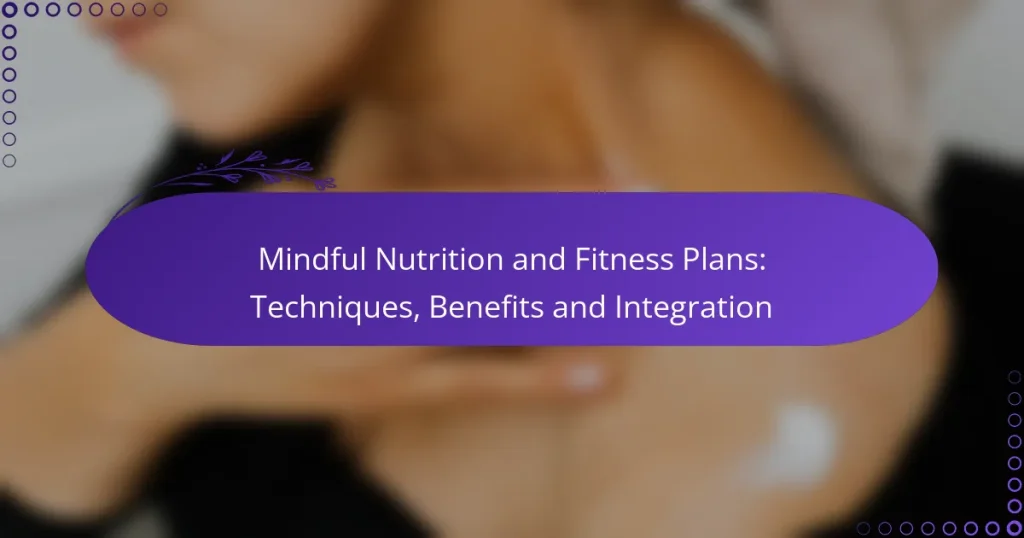Mindful nutrition plays a crucial role in enhancing fitness plans by fostering a greater awareness of food choices and their impact on the body. By prioritizing nutrient-dense foods and engaging thoughtfully with meals, individuals can improve their overall health and athletic performance. Integrating mindful nutrition into fitness routines not only aligns dietary choices with physical activity but also promotes a holistic approach to well-being.

How can mindful nutrition enhance fitness plans?
Mindful nutrition can significantly enhance fitness plans by promoting a deeper awareness of food choices and their effects on the body. This approach encourages individuals to focus on nutrient-dense foods, leading to improved overall health and performance in physical activities.
Improved energy levels
Mindful nutrition helps optimize energy levels by emphasizing whole foods rich in complex carbohydrates, healthy fats, and proteins. For example, incorporating foods like quinoa, avocados, and lean meats can provide sustained energy throughout the day. Staying hydrated and listening to hunger cues also plays a crucial role in maintaining energy balance.
Better recovery times
Proper nutrition is essential for recovery after workouts, and mindful eating can enhance this process. Consuming a mix of proteins and carbohydrates shortly after exercise can help repair muscle tissue and replenish glycogen stores. Foods like Greek yogurt with fruit or a protein smoothie can be effective choices for post-workout recovery.
Enhanced mental clarity
Mindful nutrition can lead to enhanced mental clarity by prioritizing foods that support brain health. Omega-3 fatty acids found in fish, nuts, and seeds can improve cognitive function. Additionally, avoiding processed sugars and refined carbs can help stabilize blood sugar levels, leading to better focus and concentration.
Weight management
Mindful eating practices can assist in weight management by encouraging individuals to pay attention to portion sizes and hunger signals. This approach often leads to healthier food choices and reduced emotional eating. Keeping a food journal or using apps to track intake can also help maintain awareness of eating habits.
Stronger immune system
A balanced diet rich in vitamins and minerals is vital for a strong immune system, and mindful nutrition fosters this balance. Foods high in antioxidants, such as berries, leafy greens, and citrus fruits, can help combat inflammation and boost immunity. Regularly including a variety of colorful fruits and vegetables in meals can enhance overall health and resilience against illness.

What are effective techniques for mindful nutrition?
Effective techniques for mindful nutrition include practices that enhance awareness of food choices and eating habits. These methods encourage individuals to engage with their meals thoughtfully, promoting healthier eating patterns and better overall well-being.
Mindful eating practices
Mindful eating involves paying full attention to the experience of eating, including the taste, texture, and aroma of food. This can be achieved by eating slowly, savoring each bite, and minimizing distractions such as screens or multitasking. By focusing on the sensory experience, individuals can better recognize hunger and fullness cues.
To practice mindful eating, try setting aside specific times for meals without interruptions. Consider using techniques like placing your utensils down between bites or taking a moment to appreciate the meal before starting to eat.
Meal planning strategies
Meal planning is a proactive approach to ensure balanced nutrition throughout the week. By preparing a weekly menu, individuals can select a variety of foods that meet their dietary needs and preferences. This reduces the likelihood of impulsive food choices and helps maintain portion control.
Start by creating a shopping list based on your meal plan, focusing on whole foods like fruits, vegetables, lean proteins, and whole grains. Aim to prepare meals in batches and store them in portioned containers for easy access during busy days.
Portion control methods
Portion control is essential for managing food intake and preventing overeating. Techniques include using smaller plates, measuring serving sizes, and being mindful of the amount of food served. Understanding appropriate portion sizes can help maintain a balanced diet without excessive calorie consumption.
Consider using visual cues, such as filling half your plate with vegetables, one-quarter with lean protein, and one-quarter with whole grains. This simple method can help create balanced meals while controlling portions effectively.
Mindfulness meditation
Mindfulness meditation can enhance awareness and reduce stress, which positively impacts eating habits. This practice involves focusing on the present moment and observing thoughts and feelings without judgment. Regular meditation can help individuals develop a healthier relationship with food and improve self-regulation.
To start, set aside a few minutes each day for meditation. Focus on your breath or a specific thought, allowing distractions to pass without engaging with them. Over time, this practice can lead to greater awareness during meals and improved decision-making regarding food choices.
Food journaling
Food journaling is a technique that involves recording what you eat and drink throughout the day. This practice can help identify patterns in eating habits, emotional triggers, and areas for improvement. By reflecting on your food choices, you can make more informed decisions about your nutrition.
To maintain a food journal, note not only the foods consumed but also the context, such as time of day and feelings associated with eating. This can provide insights into your eating behaviors and help you develop strategies for mindful nutrition.

What fitness plans integrate mindful nutrition?
Fitness plans that integrate mindful nutrition focus on aligning dietary choices with physical activity to enhance overall well-being. These plans emphasize awareness of food intake, body signals, and the relationship between nutrition and fitness outcomes.
Personalized workout routines
Personalized workout routines are tailored to individual fitness levels, goals, and dietary preferences. By considering factors such as age, weight, and lifestyle, these plans can optimize performance and promote healthier eating habits.
To create a personalized routine, start by assessing your current fitness level and nutritional needs. Incorporate a mix of cardio, strength training, and flexibility exercises, adjusting the intensity and duration based on your progress.
Yoga and Pilates
Yoga and Pilates are excellent for integrating mindful nutrition with fitness, as they promote body awareness and mental focus. These practices encourage participants to listen to their bodies, which can lead to healthier food choices and improved digestion.
Incorporate yoga or Pilates sessions into your weekly routine, aiming for at least two to three classes per week. Focus on breath control and mindfulness during these sessions to enhance the connection between your physical and nutritional practices.
High-Intensity Interval Training (HIIT)
High-Intensity Interval Training (HIIT) combines short bursts of intense exercise with rest or low-intensity periods, making it an efficient way to burn calories and improve fitness. This approach can also support mindful nutrition by requiring participants to fuel their bodies appropriately for high energy output.
When planning a HIIT workout, include a variety of exercises such as sprints, burpees, or jump squats. Pair these workouts with a balanced diet rich in proteins, healthy fats, and carbohydrates to sustain energy levels and recovery.
Strength training
Strength training focuses on building muscle and improving overall strength, which can enhance metabolism and support mindful nutrition. By increasing muscle mass, individuals may find it easier to maintain a healthy weight and make better food choices.
Incorporate strength training exercises at least two to three times a week, targeting all major muscle groups. Pair these workouts with a diet that includes adequate protein intake to support muscle repair and growth, ensuring you stay mindful of both your exercise and nutrition.

What are the benefits of integrating mindful nutrition and fitness?
Integrating mindful nutrition and fitness enhances overall well-being by promoting healthier eating habits and physical activity. This approach encourages awareness of food choices and exercise, leading to improved physical health, mental clarity, and emotional balance.
Holistic health improvement
Mindful nutrition and fitness contribute to holistic health by addressing physical, mental, and emotional aspects of well-being. This integration fosters a balanced lifestyle, where individuals are more attuned to their body’s needs and responses, leading to better health outcomes.
Practicing mindful eating involves paying attention to hunger cues and savoring each bite, which can prevent overeating and promote healthier food choices. Similarly, incorporating physical activity mindfully allows individuals to enjoy their workouts, reducing the likelihood of burnout and injuries.
To effectively integrate these practices, consider setting specific, achievable goals for both nutrition and fitness. For example, aim to include a variety of colorful fruits and vegetables in meals and engage in at least 150 minutes of moderate exercise weekly. Regularly reflecting on these goals can enhance motivation and accountability.


